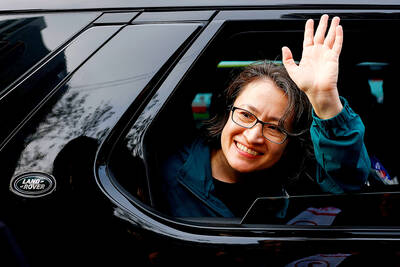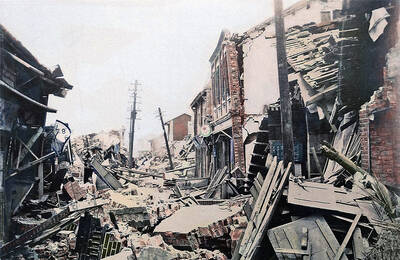“Easy-peasy,” you’re probably saying, “I should have done this years ago.”
Such are the joys of riding with a strong wind at your back, which, at this time of year, should be pushing you southwestwards for a second successive day, like a 19th-century clipper racing to deliver Queen Victoria’s favorite Oriental Beauty tea (東方美人) from New Taipei City’s Tamsui District (淡水) to London. Enjoy it while it lasts.
The Tourism Bureau’s handbook Cycling Around Taiwan sends you off down Provincial Highway 61, which is about as exciting as it sounds. In any case, you’ll have plenty of time in days to come to share the roars and fumes of fossil-fueled vehicles, so why not spend most of today on leisurely coastal paths? The only downside is that food options are fewer, but this just presents the chance to ride retro style, that is, to carry cheese sandwiches, an apple and a vacuum flask of tea in the Nelson longflap hung from your Brooks saddle.

Photo: Mark Caltonhill
In fact, today’s main activity is not so much for visiting places along the route, but more for enjoying the views and pondering times past, when local people harvested both land and sea, and when hopefully in the future they can harvest the wind too.
Leaving Hsinchu downtown, follow the railway line southwest towards the coast. After about 2km you’ll pass a weirdly time-specific statue depicting 47-year-old, Jiangsu-born Sergeant Tang Li-fa (唐立法) saving the life of a 15-month-old baby who had crawled onto the tracks in front of a speeding south-bound train at 2:26pm on Jan. 4, 1976. Tragically, Tang himself was hit on the head and died.
Another 4km brings you to the Siangshan Wetlands (香山濕地), where you join the 17km Hsinchu Coastal Bike Path. Turning south, you will see the first of the numerous wind turbines taking advantage of Taiwan’s windiest area.

Photo: Mark Caltonhill
BIZARRE DEFINITION
Avoid this section on weekends if possible, however, as bicycle rental fleets include four-wheeled, six-seater, motorized machines driven by people in the same aggressive manner they presumably terrorize cyclists on the roads. How such contraptions can be defined as bicycles is bizarre.
The baton is soon taken up by the 55km-long Miaoli Bike Way (苗栗縣綠光海風自行車道), which runs largely parallel with, close to and occasionally crosses over Highway 61.

Photo: Mark Caltonhill
On weekends at least, Longfong Harbor (龍鳳漁港) belies the earlier assertion about food options being scarce, since a wide range of fishy and other snacks are available, as well as fresh produce for those not concerned about overloading their bikes.
Next comes Jhunan Coastal Forest Recreation Area (竹南濱海森林遊憩區), winding its way through pine and mangrove woodlands, followed by a short spell on the highway to cross Chungkan River (中港溪), before signs take you through farming villages and back onto the coastal path to Waipu Harbor (外埔漁港). The tiny beach to the south of the port is a Mecca for local surfers.
Bike shops and restaurants are available 5km inland at Houlong Township (後龍) for those with needs, otherwise cross the Houlong River and pick up the final section of the bike path into Tongsiao Township (通霄).

Photos: Mark Caltonhill
A couple of interesting historical features are the shell fossil layer at Guogang (過港貝化石層) and the numerous military bunkers that point out to sea. Those with time on their hands might make a detour to the Taiyen Museum (台鹽通霄觀光園區鹽來館) of salt to learn about this aspect of the coastline’s past, when salt pans filled many of the gaps between pre-touristic fishing ports.
WHY SO FEW TURBINES
Those sticking to the bike path can continue their pondering on the preponderance of wind turbines, not with a Donald Trumpesque “Why so many?” but rather “Why so few?”

Photo: Mark Caltonhill
Having spent the whole day in the company of these giant murmuring beasts, you might imagine they make a significant contribution to the nation’s energy supply. It turns out, however, that Taiwan’s entire green sector, solar and wind combined, contributes less than 0.45 percent, according to the Ministry of Economic Affairs (MOEA) Bureau of Energy’s Energy Statistical Annual Reports 2019.
Even though this figure might be rising gradually each year, it is hard to see how it will increase sufficiently to meet the government’s avowed target of providing 20 percent of domestic energy demands from renewable sources by 2025.
On this depressing note, you arrive at Tongsiao Fishing Harbor (通霄漁港) which, being an unusual example that has not been turned into a touristy port, has zero foods options. Let’s hope you brought your sandwiches after all.

Photo: Mark Caltonhill
The bike path ends here, and after crossing the Daan River (大安溪), you have a number of routes to downtown Taichung. These include the Tourism Bureau recommended Provincial Highway 61, but more interesting are any of the innumerable back roads through some of Taiwan’s oldest Han-Chinese farmlands dating back to the 17th century.
Mark Caltonhill bikes, and writes, and writes about bikes.

Photo: Mark Caltonhill

Last week Joseph Nye, the well-known China scholar, wrote on the Australian Strategic Policy Institute’s website about how war over Taiwan might be averted. He noted that years ago he was on a team that met with then-president Chen Shui-bian (陳水扁), “whose previous ‘unofficial’ visit to the US had caused a crisis in which China fired missiles into the sea and the US deployed carriers off the coast of Taiwan.” Yes, that’s right, mighty Chen caused that crisis all by himself. Neither the US nor the People’s Republic of China (PRC) exercised any agency. Nye then nostalgically invoked the comical specter

Relations between Taiwan and the Czech Republic have flourished in recent years. However, not everyone is pleased about the growing friendship between the two countries. Last month, an incident involving a Chinese diplomat tailing the car of vice president-elect Hsiao Bi-khim (蕭美琴) in Prague, drew public attention to the People’s Republic of China’s (PRC) operations to undermine Taiwan overseas. The trip was not Hsiao’s first visit to the Central European country. It was meant to be low-key, a chance to meet with local academics and politicians, until her police escort noticed a car was tailing her through the Czech capital. The

April 15 to April 21 Yang Kui (楊逵) was horrified as he drove past trucks, oxcarts and trolleys loaded with coffins on his way to Tuntzechiao (屯子腳), which he heard had been completely destroyed. The friend he came to check on was safe, but most residents were suffering in the town hit the hardest by the 7.1-magnitude Hsinchu-Taichung Earthquake on April 21, 1935. It remains the deadliest in Taiwan’s recorded history, claiming around 3,300 lives and injuring nearly 12,000. The disaster completely flattened roughly 18,000 houses and damaged countless more. The social activist and

Over the course of former President Ma Ying-jeou’s (馬英九) 11-day trip to China that included a meeting with Chinese Communist Party (CCP) leader Xi Jinping (習近平) a surprising number of people commented that the former president was now “irrelevant.” Upon reflection, it became apparent that these comments were coming from pro-Taiwan, pan-green supporters and they were expressing what they hoped was the case, rather than the reality. Ma’s ideology is so pro-China (read: deep blue) and controversial that many in his own Chinese Nationalist Party (KMT) hope he retires quickly, or at least refrains from speaking on some subjects. Regardless